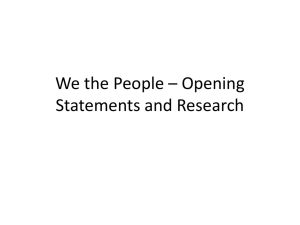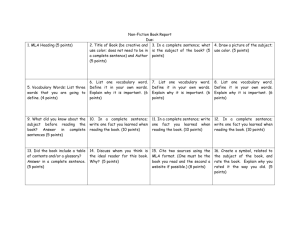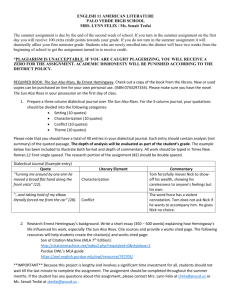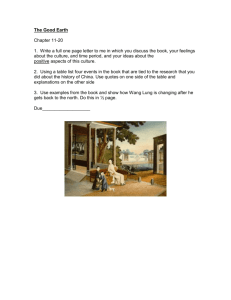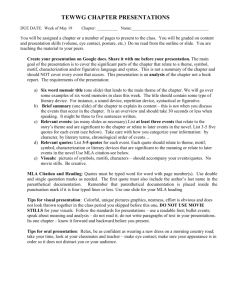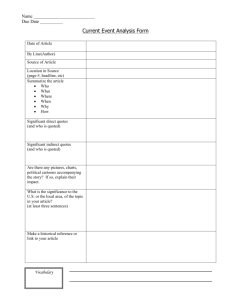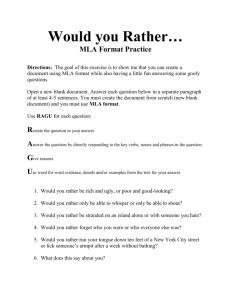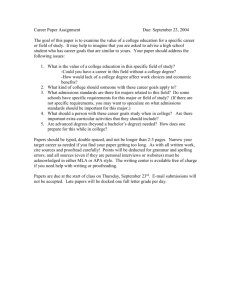2014-2015 Summer Enrichment
advertisement
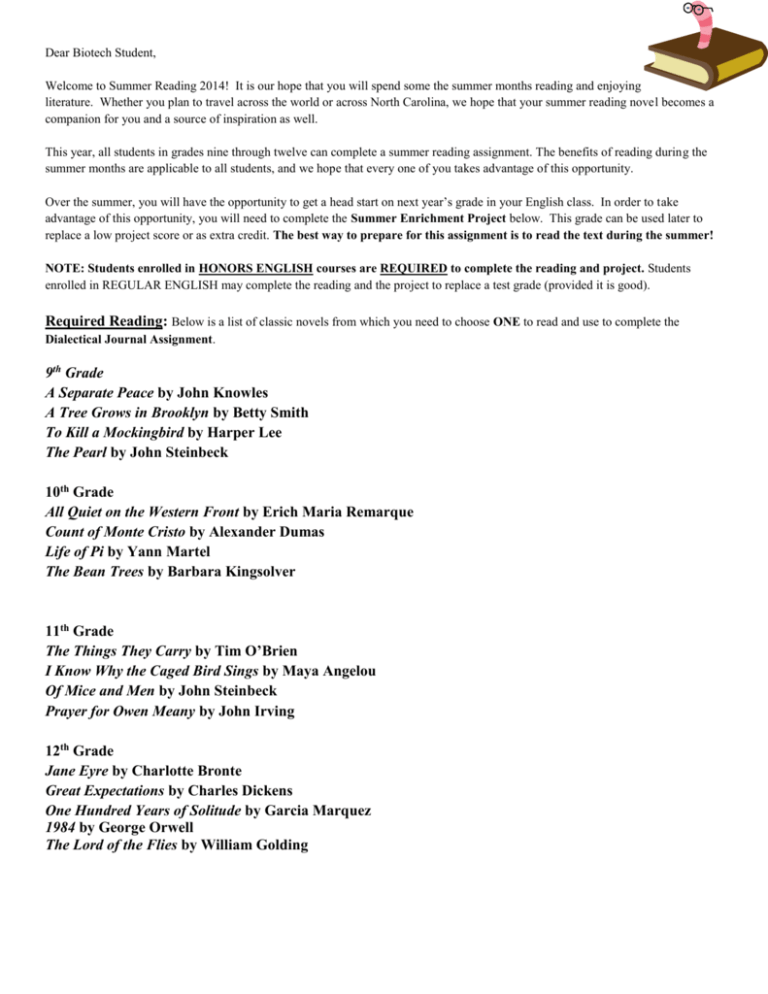
Dear Biotech Student, Welcome to Summer Reading 2014! It is our hope that you will spend some the summer months reading and enjoying literature. Whether you plan to travel across the world or across North Carolina, we hope that your summer reading novel becomes a companion for you and a source of inspiration as well. This year, all students in grades nine through twelve can complete a summer reading assignment. The benefits of reading during the summer months are applicable to all students, and we hope that every one of you takes advantage of this opportunity. Over the summer, you will have the opportunity to get a head start on next year’s grade in your English class. In order to take advantage of this opportunity, you will need to complete the Summer Enrichment Project below. This grade can be used later to replace a low project score or as extra credit. The best way to prepare for this assignment is to read the text during the summer! NOTE: Students enrolled in HONORS ENGLISH courses are REQUIRED to complete the reading and project. Students enrolled in REGULAR ENGLISH may complete the reading and the project to replace a test grade (provided it is good). Required Reading: Below is a list of classic novels from which you need to choose ONE to read and use to complete the Dialectical Journal Assignment. 9th Grade A Separate Peace by John Knowles A Tree Grows in Brooklyn by Betty Smith To Kill a Mockingbird by Harper Lee The Pearl by John Steinbeck 10th Grade All Quiet on the Western Front by Erich Maria Remarque Count of Monte Cristo by Alexander Dumas Life of Pi by Yann Martel The Bean Trees by Barbara Kingsolver 11th Grade The Things They Carry by Tim O’Brien I Know Why the Caged Bird Sings by Maya Angelou Of Mice and Men by John Steinbeck Prayer for Owen Meany by John Irving 12th Grade Jane Eyre by Charlotte Bronte Great Expectations by Charles Dickens One Hundred Years of Solitude by Garcia Marquez 1984 by George Orwell The Lord of the Flies by William Golding Guidelines for Novel Dialectical Journal: Dialectic means “the art or practice of arriving at the truth by using conversation involving question and answer.” The “dialectic” was the method Socrates used to teach his students how to be actively engaged in the struggle to obtain meaning from an unfamiliar and challenging work. A dialectical journal is a written conversation with yourself about a piece of literature that encourages the habit of reflective questioning – a habit that should be firmly ingrained by the time you leave this class. Absolutely NO collaboration with another student is permitted. Any assistance from the internet, movies, or secondary sources such as SparkNotes or Cliff Notes will be perceived as cheating. Instructions: 1. 2. 3. 4. 5. Purchase a composition book. Fold pages in half vertically or draw a vertical line down the middle of each page. Label the top of each column: left side, TEXT; right side, RESPONSE. Skip pages (write on one side of the page only). In the TEXT column, cite passages verbatim from the book; including quotation marks and page numbers. a. Choose two-three quotes from each chapter (depending on the novel chosen). b. Use MLA format for all direct quotations and citations. c. How to choose quotes: i. Details that seem important to you ii. You have an epiphany (look it up) iii. Your learn something significant iv. You agree or disagree with something the author says or does v. You find an interesting or potentially significant quotation vi. You notice something important or relevant about the writer’s style vii. You notice effective use of literary devices 6. In the RESPONSE column, reflect upon the passages (you must use each one of the letters at least once): a. make personal connections b. make associations to other texts or events c. share feeling about the ideas, tone, and/or style d. question parts of the passage you do not understand e. comment about what you think is important f. speculate about the significance of images g. comment about the repetition of ideas, words, phrases, and/or images h. make connections between quotes chosen in the text i. explain or speculate about symbols or motifs j. speculate about theme k. address questions that are raised as you read 7. DO NOT MERELY SUMMARIZE. 8. Each RESPONSE must be at least 50 words (include the word count at the end of each response). 9. Write down your thoughts, questions, insights, and ideas while you read or immediately after reading a chapter so the information is fresh. 10. As you take notes, re-read previous pages of notes and comments. 11. First person reference is acceptable in the RESPONSE column. 12. Write a detailed 8-10 sentence analysis of the entire text – do not summarize – a summary is not an analysis Dialectic journals will be assessed on your choice of quotes: Are they meaningful? Do they reflect the ideas discussed? Are the quotations significant? Is interpretation and commentary about the text thoughtful? Do you include commentary on various literary devices such as theme, narrative voice, imagery, conflict, etc., AND how each contributed to the meaning of the text? Do you comment on your understanding of how comics and “sequential visual art” work? Do you make insightful personal connections and ask thought-provoking questions? Is coverage of the text thorough? Is the journal neat, organized and professional-looking? Did you follow directions? Is your analysis detailed and dealing with the entire text? Dialectical Journal Format (Sample only – yours must be handwritten) Text Title: _____________________________ Author: _____________________ Reference to the Text Response Type # In the space below, copy direct The quotations, citations, summaries, letter of paraphrases, key words, and/or the other clear references to the text that Response used from “speak to you.” Use MLA format the for all direct quotations and column citations. on the right Example: “I hurled orange peels t the mouth of an open garbage can, and when the peels were gone I watched the white puffs of my breath thin to nothing” (Soto 50). g Responses to the Textual Examples In the space below, write your responses. You may (a) make personal connections; (b) make associations to other texts or events; (c) share feeling about the ideas, tone, and/or style; (d) question parts of the passage you do not understand; (e) comment about what you think is important; (f) speculate about the significance of images; (g) comment about the repetition of ideas, words, phrases, and/or images; (h) make connections between quotes chosen in the text; (i) explain or speculate about symbols or motifs; (j) speculate about theme; and/or (k) address questions that are raised as you read. Example Response: The mouth of the trashcan reflects to the image of the monster eating orange peels. When the boy is throwing orange peels into the trashcan is symbolizes that the jacket is peeling and that he wants to throw it away. The breath thins to nothing is used to show that the boy is watching his life disappear. Even though he can do something about it, he doesn’t. In turn, he is throwing his life away. Analysis (8-10 sentences): Dialectical Journal Rubric for Novel Summer Enrichment Assignment Formatting (Neatness, professional appearance, and set up) Quotes in MLA format Response 5 Follows all of the formatting instructions and guidelines All quotes are in MLA format Responses fully reflect ideas and add meaning Connection to self and addresses thought provoking questions Insightful connections that address thought provoking questions Analysis Analysis is thorough, detailed, and is 9-10 sentences in length 4 Follows most of the formatting instructions and guidelines Most quotes are in MLA format Responses mostly reflect ideas and add meaning Most connections are insightful and address thought provoking questions 3 Follows some of the formatting instructions and guidelines Some quotes are in MLA format Responses somewhat reflect ideas and add little meaning Connections are somewhat insightful and address thought provoking questions Analysis is mostly thorough, detailed, and is 7-8 sentences in length Analysis is somewhat thorough, detailed, and is 5-6 sentences in length 2 Follows very few of the formatting instructions and guidelines Very few quotes are in MLA format Responses do not fully reflect ideas and add very little meaning Connections inconsistently reflect insight and offers very few ideas about thought provoking questions Analysis lacks detail, and is 3-4 sentences in length 1 Follows very little of the formatting instructions and guidelines Limited quotes are in MLA format Responses do not reflect ideas and lack meaning Connections are not insightful and offer limited ideas about thought provoking questions Analysis has limited detail, and is 1-2 sentences in length TOTAL SCORE FROM RUBRIC: _________________ X 2 = _____________/50 points
